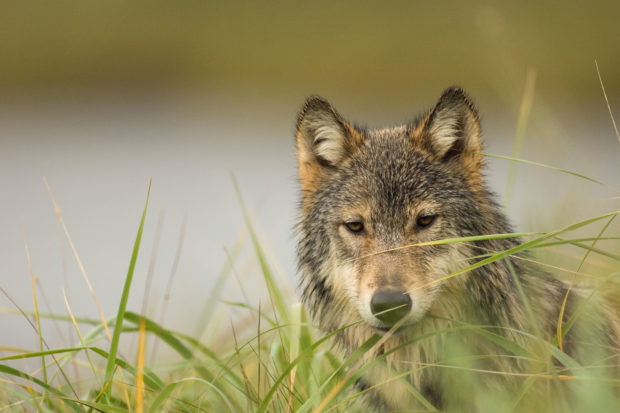Denali National Park’s East Fork wolf pack has been decimated by human killing, according to experts who spoke yesterday (August 3rd) to Alaska Public Radio. The den site for a key female in the pack is vacant, and it appears that trophy hunters and trappers have snared or shot three of the radio-collared wolves in the social group. It was a continuously studied wolf pack for 70 years, and it may have been the most viewed pack in history—an enormous draw for visitors to Denali. Because of a lack of Denali wolves, wolf watchers are now going to Yellowstone National Park.
In Denali, the damage has been done already. But this tragic story underscores the importance of yesterday’s policy announcement by the U.S. Fish and Wildlife Service (USFWS) to stop ruthless predator control practices on national wildlife refuges (along with a similar policy enacted by the National Park Service earlier in the year). There are over 76 million acres of national wildlife refuges in the state of Alaska, and they are home to wolves and other species whose survival has time and again been compromised by reckless killing and management.

There are over 76 million acres of national wildlife refuges in the state of Alaska, and they are home to wolves and other species whose survival has time and again been compromised by reckless killing and management. Photo by Alamy
In fact, yesterday’s action by USFWS is one of the most significant wildlife management protective actions in years, coming after decades of killing of bears, wolves, and coyotes, with the aid of airplanes, snares, and bait (and even killing mothers, pups, and extended families at den sites). Voters in Alaska twice banned aerial hunting of wolves and wolverines, but state lawmakers overturned the ballot measures each time, in what can only be considered extreme anti-democratic behavior. Former governors Frank Murkowski and Sarah Palin were particularly active boosters of these ruthless predator-control practices.
As I wrote in yesterday’s blog, every single one of the political appointees on the current Board of Game are active trophy hunting or trapping advocates, a number of whom are involved directly in the wildlife-killing industry.
USFWS director Dan Ashe, himself a hunter, said it best: “Over the past several years, the Alaska Board of Game has unleashed a withering attack on bears and wolves that is wholly at odds with America’s long tradition of ethical, sportsmanlike, fair-chase hunting, in something they call ‘intensive predator management.’”
The USFWS said the vast majority of public comments, including the comments from Alaskans, favored the federal policy action to restrict predator control.
Leading wildlife advocates and scientists in Alaska chimed in yesterday with their own statements of support.
“These final regulations are a major step toward assuring the American people that our National Wildlife Refuges in Alaska will continue to be administered according to the provisions of the Alaska National Interest Lands Conservation Act: to protect natural diversity, ecological processes, biological integrity,” said Francis Mauer, a retired wildlife biologist for the USFWS.
Alaska-based professor and conservation biologist, Richard Steiner, added, “Alaska’s national wildlife refuges are global treasures. For years, the State of Alaska’s backward wildlife management system has seriously degraded wildlife populations on these national interest lands. This new rule goes a long way toward reversing years of mismanagement by the state, and in finally protecting these precious national interest lands for all Americans. Many Alaskans are delighted with these long-overdue federal protections.”
Yet, in spite of yesterday’s action, the debate is not over. Just like state lawmakers overturned the voters’ wishes in Alaska, federal lawmakers are now trying to undo the actions of federal professional wildlife managers.
“Make no mistake—the size, scope and impact of this rule is enormous,” U.S. Rep. Don Young wrote in a statement. “This unilateral power grab fundamentally alters Alaska’s authority to manage wildlife across all areas of our state.” Young is the author of amendments to several bills to undo the actions of the USFWS and a similar rulemaking action by the National Park Service. Young overstates that this will harm subsistence hunters in Alaska but it will do no such thing.
Alaska residents also indicated in a March 2016 poll their strong support for putting a stop to those killing methods on national wildlife refuges. These lands don’t belong to the trophy hunting group or even just to Alaskans. They are there for all of the people of the United States. And it’s quite clear that the vast majority of people don’t want these barbaric predator killing practices used on the most important federal lands set aside for wildlife.
Yesterday’s action by USFWS Director Dan Ashe and President Obama is one to celebrate. But we’ll have to be active in the months ahead to protect it from an attempt by lawmakers in Congress to override it. There’s a lot at stake.
The post Congressional battle looms over new policy to tamp down ruthless predator control on federal lands in Alaska appeared first on A Humane Nation.
Related Stories
- Breaking news: Obama administration grounds aerial hunting, other inhumane predator-killing practices on refuges in Alaska
- Time to get the lead out of federal wildlife management policies
- Loss of mammals throughout the world a crisis of our own making
Enviroshop is maintained by dedicated NetSys Interactive Inc. owners & employees who generously contribute their time to maintenance & editing, web design, custom programming, & website hosting for Enviroshop.
